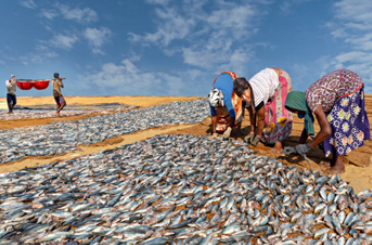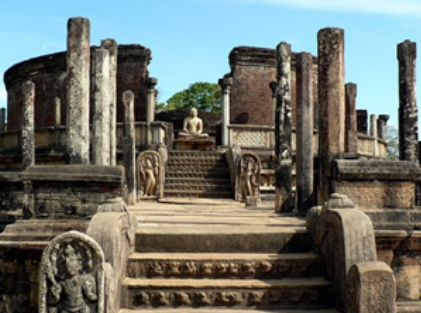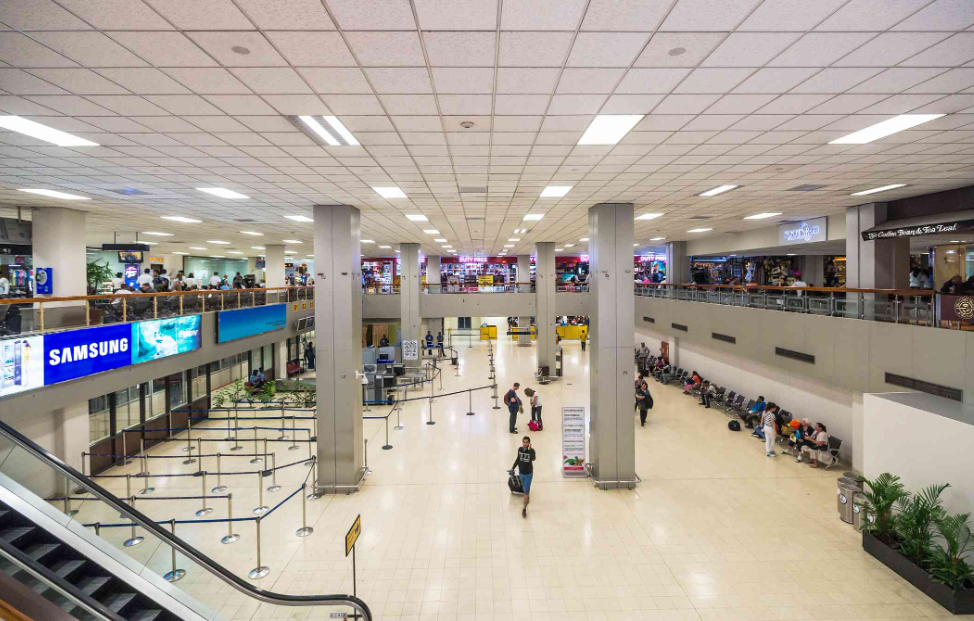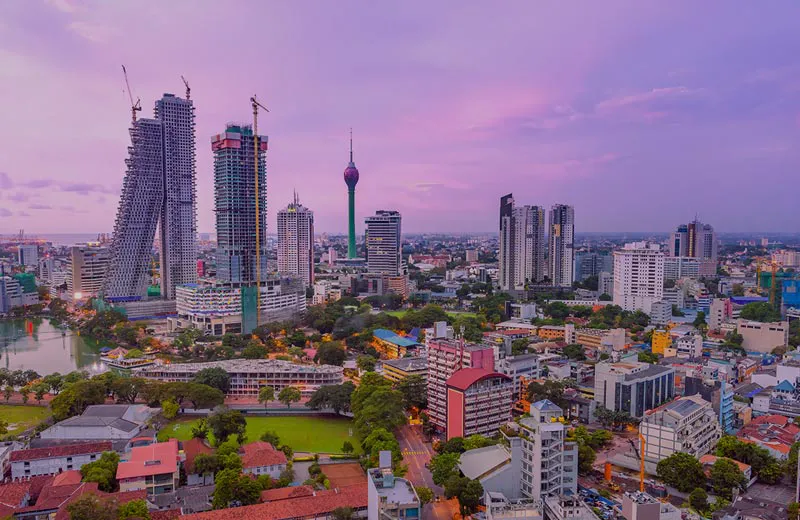- Home
- Culture, Heritage, Nature & Wildlife – Luxury Summer Vacation – 14 Days 13 Nights
Starting at $3999pp
for 14 days.
Based on two persons sharing

Culture, Heritage, Nature & Wildlife - Luxury Summer Vacation – 14 Days 13 Nights
14 Days / 13 Nights
Quick look
The history of Sri Lanka is said to date back to the third century before the common era. This journey will take you to four different UNSECO world heritage sites, each of which offers a different opportunity to learn about the history of Sri Lanka.
In addition, despite the fact that Sri Lanka is known as a bio-diversity hotspot in the world, this tour will take you to three separate national parks, each of which offers an experience that is unmatched by the others. The Minneriya and Kaudulla National Parks are famous for hosting one of the largest gatherings of elephants in the world. The Kumana National Park is famous for its leopard population, while the Gal-Oya National Park Inginiyagala Lake boat safari is famous for its bird life and elephant swimming.
The Royal Botanic Gardens Peradeniya is a botanical garden that is known all over the world and has over 4000 different kinds of plant species.
During your Negombo Lagoon boat safari, you will be in close proximity to mangroves, which are among the most recognizably different types of vegetation found across the globe.
By going to the Negombo Dry Fish Market and the Negombo Hamilton Canal, you will have the opportunity to learn about the daily lives of fisherman in Sri Lanka. Additionally, by doing the rural village tour in Habarana, you will have the opportunity to learn about the everyday lives of villagers in rural areas of Sri Lanka.
A trip to Kiriporuwa Lake, followed by a stroll around the surrounding village, as well as a trip to Radalla Lake, will provide you valuable insight into the country’s natural landscapes, diverse species, and traditional ways of life.
Price Includes
- Entrance fees to site visits and excursions mentioned in the itinerary
- All game drive jeep service charges are listed in the itinerary.
- Accommodation for 13 days in the hotels included in the package on a bed and breakfast basis
- According to the tour plan, transportation by air-conditioned car
- For the round tour, an English-speaking chauffeur guide will accompany you.
- Water bottle that can be reused.
Accommodation and excursions are subject on availability.
Please be advised that costs for site visits, excursions, and hotel stays may change depending on the current situation.)
Highlights
- Immerse yourself in the culture & heritage.
- Discover Sri Lanka’s rural lifestyle.
- Enjoy the wildlife and nature of Sri Lanka.
- Relaxation on untouched sandy beaches.
Tour Map

Tour at Glance
- Negombo Fish Market – feel like a local
- Negombo Hamilton Canal boat safari
- Negombo Lagoon boat safari
- Dambulla Cave Temple (UNESCO World Heritage Site)
- Sigiriya Ancient City Complex visit (UNESCO World Heritage Site)
- Rural village visit – feel like a local
- Game Drive – Elephants gathering at Minneriya National Park
- Polonnaruwa Medieval City (UNESCO World Heritage Site)
- Radella Lake visit – Jeep Safari feel like a local
- Game Drive at Kumana National Park
- Gal Oya rural village visit feel like a local
- Gal-Oya National Park Boat Safari with Picnic Breakfast
- Kandy Temple of the Tooth Relic
- Peradeniya Royal Botanical Garden
- Colombo afternoon city walk.
Airport > Negombo > Dambulla > Sigiriya > Polonnaruwa > Pasikuda > Arugam Bay> Gal-Oya > Kandy > Colombo > Airport
Day - 01
Negombo
- Transfer: Airport > Negombo
- Accommodation : Villa Hundira or Similar
- Over night stay : Negombo

A representative will be waiting to pick you up at the Bandaranaike International Airport to
drive you to your accommodation.
Drive: 15km, approximately 30 minute’s drive.
Leisure day at Negombo
The majority of the people who live in Negombo are Catholic, which is why the area is often referred to as “Little Rome” due to the abundance of Catholic churches. The town has a long history of fishing, and its sandy coastline and storied fishing industry date back generations. Negombo is home to a sizeable Roman Catholic community that speaks both Sinhala and Tamil. As the site of the country’s second-largest fish market, Negombo is an important center for the fishing industry. The town’s history as a colonial port and its hundreds of brightly painted boats have contributed to making Negombo a melting pot of cultures and religions.
Day - 02
Negombo
- Stay : Negombo
- Accommodation : Villa Hundira or Similar
- Over night stay : Negombo



If you’re interested in visiting one of Negombo’s fish markets, your chauffeur guide will drive
you there whenever it’s most convenient for you. Later that day, you’ll take a boat safari
along the Hamilton Canal and lagoon with the assistance of your chauffeur guide.
Negombo fish market Feel like a local
There are two different types of fish markets in Negombo: a wet fish market and a dry fish market. The doors to the wet fish market open at 03.30 in the morning, while the doors to the dry fish market open at 08.00 in the morning.
(It is important that you keep in mind that the area smells strongly of fish, as does every fish market. If you are someone who is easily bothered by odours, you should not come here.)
When it comes to the wet fish market, the ideal time to go is at 5:00 in the morning, whereas the best time to go to the dry fish market is at 9:00 in the morning.
You can get a sense of the day-to-day life of Sri Lanka’s fishing community by visiting the wet and dry fish markets in Negombo, which are very bustling and dynamic fish markets.
Negombo Lagoon Safari
The Negombo Estuary and Lagoon is located in the southwest corner of Sri Lanka and is a large estuary lagoon that is fed by a number of smaller rivers as well as a canal. It is connected to the sea by a narrow stream that is located to the north, close to Negombo. Both farming and fishing are carried out on this site.
Huge mangrove swamps can be found inside the lagoon. These wetlands serve as a breeding ground for a wide variety of water birds, including cormorants, herons, egrets, gulls, terns, and other waders. The people who make their living fishing in Negombo take use of the lagoon. Both the crabs and prawns that live in lagoons are quite popular and in great demand.
Both the evening sunset and Monkey Island are popular attractions for tourists.
Negombo Hamilton Canal Boat Safari
Connecting Colombo and Puttalam via Negombo, the 14.5-kilometer-long Hamilton Canal is also known as the Dutch Canal. Abu Zayd al-Balkhi, a Persian geographer, spent a week in the eighth century writing about his journey through the ‘Gobbs of Serendib, ‘ the Arabian name for the chain of connected lagoons that forms the canal. The Portuguese constructed a canal connecting Hendala and Pamunugama in the 17th century. In an effort to remove saline water from rice fields and bring cinnamon to the port of Negambo, the Dutch constructed a series of buildings, dams, and canals that used and improved upon the old system of waterways. From the Kelani River’s mouth at Hekitta to the Negombo Lagoon’s southern border at Pamunugama, a distance of 14.5 kilometers, the British constructed a new canal in 1882 that ran parallel to and west of the earlier Dutch Canal, closer to the sea. Government Agent for Revenue and Commerce Gavin Hamilton (1494–1803) was honored
with the naming of this waterway.
Day - 03
Sigiriya
- Transfer: Negombo > Sigiriya
- Accommodation : Water Garden or Similar
- Over night stay : Sigiriya

After breakfast, you will take a 140km, approximately 3 hour and 30 minute drive from Negombo to Sigiriya. Along the way, you will make a stop at the Dambulla Cave Temple where your chauffeur guide will provide you with background information on its history. In the afternoon, you will return to the hotel to relax and take it easy.
En-route visit: Dambulla Cave Temple (UNESCO World Heritage Site)
The Golden Temple of Dambulla, also known as the Dambulla Cave Temple, was added to the list of World Heritage Sites in 1991. It contains three sculptures of Sri Lankan rulers and four statues of gods and goddesses, as well as 153 statues of Buddha. The total square footage of the murals in the temple is approximately 23,000 square feet (2,100 meters). The Dambulla cave complex has five different caves that date back to different epochs. The caves feature impressive artwork depicting Buddha’s first sermon and his struggle against seduction by the demon Mara.
Day - 04
Sigiriya
- Stay : Sigiriya
- Accommodation : Water Garden or Similar
- Over night stay : Sigiriya


You will go on an excursion in the village with a local guide and your chauffeur guide first thing in
the morning today. You will get the opportunity to live as a local in a rural community. – feel like a
local
After lunch, you will be driven to either Minneriya or Kaudulla National Park by your private guide
and car.
Rural village visit with authentic lunch – feel like a local
The rural people’s way of life in the villages differs from area to region. You will get the opportunity to visit a rural community while taking part in the Habarana village walk, which will give you the chance to interact with locals and gain insight into their way of life. During the village walk, you will be led through rural farms and acres of paddy fields, giving you the opportunity to get an up-close and personal look at village life. You will have the opportunity to form relationships with people, participate in local fishing, and on occasion taste locally prepared food. And to cap off the whole experience, you’ll get to enjoy a delicious meal after watching a quick cooking demonstration.
Afternoon Game Drive – Elephants Gathering at Minneriya National Park
The gathering of elephants is a phenomenon that is considered to be one of the natural wonders of the world and may be witnessed in Sri Lanka. During the gathering season, visitors will get the opportunity to see anything from one hundred to three hundred elephants in a single herd, making it the greatest gathering of Asian elephants in the world. During the dry months, from July to October, the tank acts as a migration path for these enormous beasts from many of the neighboring locations as they seek water and new grass, which has all dried up elsewhere. This “migration” path serves as a safe haven for them during the dry months. They congregate in herds of up to 300 individuals at this time, marking the beginning of the greatest gathering of Asian Elephants ever seen.
Day - 05
Sigiriya
- Stay : Sigiriya
- Accommodation : Water Garden or Similar
- Over night stay : Sigiriya

You and your chauffeur guide are going to spend the day seeing the Sigiriya Ancient City Complex,
and throughout your time there, your guide will educate you on the region’s rich history. If you
want to see the sunrise or the sunset, the best time to go is either very early in the morning or
very late at evening.
Sigiriya Ancient City Complex Visit (UNESCO World Heritage Site)
In the fifth century CE, King Kashyapa is believed to have founded the Sigiriya City Complex, which is recognized as a world heritage site by UNESCO and referred to as the “Eighth Wonder of the World.” Sigiriya is an historic city complex in Asia that has been well-preserved, featuring four distinct gardens based on natural themes. The paintings and graffiti found at Sigiriya depict daily life in Sri Lanka from the fifth century CE. Furthermore, the ancient architecture of Sigiriya highlights the importance of skills such as geometry, mathematics, ceramics, and water management.
Day - 06
Pasikuda
- Transfer: Sigiriya > Pasikuda
- Accommodation : Karpaha Sands or Similar
- Over night stay : Pasikuda

You will leave Sigiriya today, and your chauffeur guide will travel with you to Polonnaruwa, the second ancient capital of Sri Lanka. A wealth of information on Sri Lanka’s history may be gained by visiting the ruins of the old city, which have both Buddhist and Hindu influences. After your exploration of Polonnaruwa, you will make your way to Pasikuda by car.
Drive: Sigiriya to Polonnaruwa – 55km, approximately 1 hour and 30 minutes’ drive.
Drive: Polonnaruwa to Pasikudha – 70km, approximately 1 hour and 45 minutes’ drive.
En-route visit: Polonnaruwa Medieval City (UNESCO World Heritage Site)
The Sinhalese monarch first created Polonnaruwa as a military stronghold in the beginning of the city’s history. After the Chola dynasty’s successful invasion of the country in the 10th century, they bestowed the name “Jananathamangalam” upon the territory they conquered. Vijayabahu organized a battle against Polonnaruwa with three separate troops coming from three separate directions.
In the year 1070, Vijayabahu was crowned king of Polonnaruwa. During this period, the island nation of Sri Lanka was known by the name Thambapanni. The Buddhist and Hindu structures that make up Polonnaruwa date from the 10th century CE to the 13th century CE and were built throughout that time period.
People started moving out of Polonnaruwa before the end of the 13th century and migrate to the south-western region of the country.
Day - 07
Pasikuda
- Stay : Pasikuda
- Accommodation : Karpaha Sands and Spa or Similar
- Over night stay : Pasikuda

You are free to spend the day exploring the East Coast of Sri Lanka. You may go swimming in the
water since it is so calm, or you can use the pool at the hotel.
Leisure beach stay
Pasikudah is a beach resort town situated 35 kilometers northwest of Batticaloa in the Batticaloa District of Sri Lanka. The name Pasikuda means “Green-Algae-Bay” in Tamil. It used to be a quiet Tamil village located near the Kalkudah River. Pasikudah has been heavily impacted by both the Indian Ocean Tsunami of 2004 and the Sri Lankan Civil War.
Pasikudah is home to one of the longest stretches of coastline protected by shallow reefs. The water is only a few feet deep, and the current is much weaker compared to other parts of Sri Lanka’s coast. This makes it possible for people to walk for kilometers into the sea.
Day - 08
Arugam-Bay
- Transfer: Pasikuda > Arugam-Bay
- Accommodation : Jetwing Surf or Similar
- Over night stay : Arugam-Bay

Following breakfast, you will be transferred to Arugam Bay by vehicle. Your route will take you past rice fields and farms along the coast, where you’ll have the opportunity to observe a diverse range of ecosystems.
Drive: 150km, approximately 04 hour’s drive.
Afternoon Radella Lake visit- Jeep Safari – feel like a local
You are going to visit Raddalla village Lake with your chauffeur guide today in the late afternoon, and you will journey there by jeep. You will get the opportunity to view real life in a rural community as well as a wide range of animals in their natural habitat.
Day - 09
Arugam-Bay
- Stay : Arugam-Bay
- Accommodation : Jetwing Surf or Similar
- Over night stay : Arugam-Bay

In the morning, once you have some free time, you will have the option of spending it at the beach or at the hotel pool, whichever you want. You will be driven to Kumana National Park by a private guide and chauffeur in the afternoon.
Afternoon Game Drive at Kumana National Park.
One of the national parks in Sri Lanka that receives the fewest visitors is Kumana National Park, which is really a part of Yala National Park. The park was closed from 1985 all the way up until March of 2003 as a result of attacks by the LTTE (Liberation Tigers of Tamil Eelam). The Boxing Day Tsunami of 2004 was another event that had an effect on it. The dry season in Kumana, which runs from February all the way through September, is the best time to go hiking and exploring in the area. Even outside of the migratory season, which takes place from May to July, there are numerous kinds of birds that may be observed and appreciated. Yala National Park incorporates the Kumana Bird Sanctuary, which first opened its doors in 1938. One of the most significant areas in Sri Lanka for the nesting and breeding of birds is called Kumana. There are 255 distinct species of birds who make this national park their home. From April to July, the Kumana wetland region is visited by tens of thousands, if not hundreds of thousands, of different species of birds.
Day - 10
Gal Oya
- Transfer: Arugam-Bay > Gal Oya
- Accommodation : Gal Oya Lodge or Similar
- Over night stay : Gal Oya

Today, you and your chauffeur guide will leave Arugam Bay for Gal-Oya. The Gal-Oya is a river in south-east Sri Lanka that stretches for 67 miles (108 kilometers). It is the sixteenth longest river in Sri Lanka. After the river was dammed in 1948 as part of the Gal-Oya plan, the population of GalOya increased. The Gal Oya project resulted in the formation of the 100,000-acre Gal Oya basin. We presently cultivate paddy, chillies, sugarcane, and potatoes in this area. Bears, leopards, and elephants are just some of the animals that call the adjacent Gal-Oya National Park home. Located in the Gal-Oya National Park, Sennayake Samudaraya (Inginiyagala Lake) is one of the biggest lakes in Sri Lanka.
Drive: 115km, approximately 03 hour’s drive.
Late afternoon, Gal- Oya rural village visit and Kiriporuwa lake visit – feel like a local
This afternoon, you will be exploring the region with a naturalist who is well familiar with it. To get to Kiriporuwa Lake, the best place to see birds in the region, you and your naturalist may take a stroll through the hamlet.
Day - 11
Kandy
- Transfer: Gal-Oya > Kandy
- Accommodation : Ellerton Bungalow or Similar
- Over night stay : Kandy

Following your boat safari on the Inginiyagala reservoir, your chauffeur will take you to Kandy. The route passes through rural areas and rice farms, perfect for spotting local animals. When you get there, you can relax for the rest of the day.
Drive: 155km, approximately 04 hour’s drive.
Gal-Oya National Park Inginiyagala reservoir boat safari with picnic breakfast
Today, about 05.30 a.m., you start from the hotel for a boat safari on Inginiyagala lake. The Inginiyagala reserve is part of the Gal-Oya National Park. Gal-Oya > Inginiyagala Lake > Hotel (Gal-Oya)
Drive: 35km, approximately 01 hour drive. (One way)
The trip begins at 5:30 a.m., when you and your naturalist set off from the hotel. It’s a fantastic journey through breathtaking landscapes, and you could even see some species. The boat voyage takes around two to three hours, but the calm reservoir waters let you unwind. Several species of birds, both those that live on Sri Lanka year-round and those that fly in for the winter, can be seen from the boat. Elephants can often be seen swimming from the mainland to the islands or from one island to another; crocodiles in the shallows are also possible.
Day - 12
Kandy
- Stay : Kandy
- Accommodation : Ellerton Bungalow or Similar
- Over night stay : Kandy


Today, your chauffeur guide will take you on an excursion across Kandy. You are going to go to the Temple of the Tooth as well as the Royal Botanical Gardens, and if there is enough time, you are also going to go on an excursion through Kandy City with your chauffeur guide. The last kingdom in Sri Lanka, Kandy is situated in the country’s rainy zone at an elevation of 500 meters above sea level. It is said that the Buddha’s left canine tooth is preserved in the Temple of the Tooth, which is located in the city of Kandy, which has been designated a UNSECO historic city. It was the British in the 1940s that laid the foundations for what is now Kandy’s most popular tourist destination: the Royal Botanical Gardens.
Kandy Temple of Tooth
Kandy, Sri Lanka is home to a Buddhist temple known as Sri Dalada Maligawa, also known as the Temple of the Sacred Tooth Relic. It may be found within the compound of the former royal palace of the Kingdom of Kandy, which is also the location of a relic of the tooth of the Buddha. Since ancient times, the relic has been an important factor in the politics of the region due to the widespread belief that whoever possesses the relic has complete control over the governance of the land. Throughout history, Sinhalese kings and queens have been in possession of the artifact. Both the temple itself and the relic that it houses have contributed to the Temple of the Tooth’s status as a World Heritage Site.
Royal Botanical Gardens
The garden is home to over 4000 different types of plant life, some of which include orchids, spices, medicinal plants, and palm trees. The Botanical Park encompasses a total area of 147 acres (0.59 km2), is located 460 meters above sea level, and receives an average of 200 days of precipitation per year. The Department of National Botanic Gardens is in charge of its administration. When King Wickramabahu III ascended to the throne and established his court at Peradeniya on the Mahaweli River in 1371, the Botanic Gardens were already in existence at that time.The Kew Garden, Slave Island, and the Kalutara Garden in Kalutara all contributed species to the foundation of the Peradeniya Botanical Garden in 1843.
Day - 13
Colombo
- Transfer: Kandy > Colombo
- Accommodation : Galle Face Hotel or Similar
- Over night stay : Colombo

You’re making the trip from Kandy to Colombo today. Your chauffeur guide will point out interesting landmarks along the way to Colombo. In the late afternoon, you and your driver guide will have a stroll through Colombo’s streets.
Drive: 122km, approximately 04 hour’s drive.
Afternoon Colombo City Walk
The capital city of Sri Lanka, Colombo, is situated on the island’s western coast, which acts as the country’s primary entry point to the rest of the world. Colombo is a young city in comparison to the history of Sri Lanka, which spans 2500 years. The arrival of Muslim merchants in the area around Colombo in the ninth century marked the beginning of the city’s growth. Colombo, on the other hand, grew to prominence and eventually became the most important trading centre on the island with the entry of western powers. The city of Colombo serves as the principal financial and commercial hub of Sri Lanka. In addition to modern developments like Port City and Lotus Tower, the city of Colombo is home to historical buildings that date back to the city’s colonial era, including Buddhist temples, Hindu temples, Mosques, and other monuments.
Day - 14
Departure
- Transfer: Colombo > Airport
- Departure

On the last day of your holiday in Sri Lanka, after you have had a leisurely breakfast, you will be transported to the airport in plenty of time for your journey home.
Drive: 30km, approximately 45 minute’s drive.

Negombo Fish Market

Negombo Hamilton Canal boat safari

Negombo Lagoon boat safari

Rural village visit

Minneriya National Park

Radella Lake

Kumana National Park

Gal-Oya National Park

Kandy Temple

Peradeniya Royal Botanical Garden

